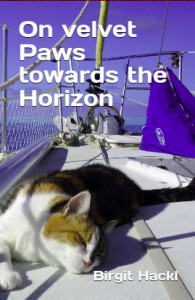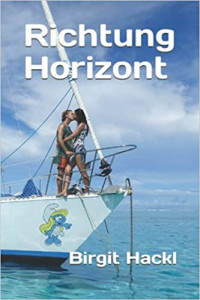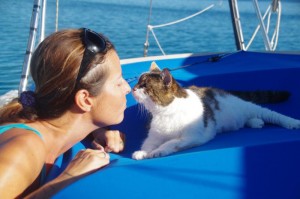Getting our anchors up was easier than expected. Now we’re sailing goose-winged downwind in 15 kn from the East. Our friends the brown boobies have been following us, which was of course very nice of them, but made fishing almost impossible. First we didn’t dare to put a lure out, but after 20 nm we thought they had left. Each time we tried fishing again, a group showed up and we quickly rolled the lures in to avoid catching one of them…
2018
04
Aug
2018
03
Aug
Difficult paradise
This morning we are getting ready to leave Car o line Atoll. As hobby-ornithologists we enjoyed our stay here immensely–there are not many places left in the Pacific where such big colonies are still nesting. As going ashore is impossible unless the sea’s completely calm we didn’t spend as much time on the motus as we would have liked to, but of course the snorkeling was also interesting.
It was an exciting week, but of course we also worried a lot. Each time we ventured ashore we had to deal with the hassle of paddling the dinghy up on the shelf without getting caught by breakers. And of course during our time ashore the nagging worries at the back of our heads remained: What if the swell picked up and we wouldn’t be able to get off in time? What if the dinghy got flipped in a breaker and we’d be stranded miles from the boat without a working outboard engine? What if the wind shifted and Pitufa was swept against the reef before we could get to her? What if she broke free and was gone by the time we returned??
We take nothing but pictures and our impressions away from the island and of course we left nothing but footprints (as we always do). Car o line is a wildlife reserve and we hope that other cruisers respect it as we do. Even if somebody wanted to exploit the ressources of the island they would have a hard time: Anchoring on the steep shelf is a real challenge, lobstering would be quite difficult on the reef with breaking waves and even more so getting back to the boat unscathed in the dark, coconut crabs seem to live mainly on the southern and northern motu (where there are palm trees), but there’s no safe anchorage close to these motus. The ciguatera situation is also unclear.
All went well and we’re glad we came here. Now we hope that we’ll get our two anchors, chains and lines back aboard. The young brown boobies will miss their floating playground and we’ll miss them ![]()
2018
03
Aug
Underwater world
Whenever the sea’s not completely calm going ashore is out of question here, so we’ve concentrated on the underwater world for the past few days. The reef looks different from what we’re used to: In the shallow water the coral’s mainly dead (apart from some baby staghorn giving it another try), but between 5 and 10 m and in some places down into the drop-off beautiful stone coral in different shapes (plenty of Pachyseris, they look like morels growing on a tree trunk…) cover impressive bommies and deep canyons in between.
There are many fish around, but not too many different species:
We always have a few grey reef sharks, black-tip reef sharks and white-tip reef sharks accompanying us, but they’re mainly small. As we’re out on the ocean here we expected to see some big oceanic species and were always hopefully keeping one eye out towards the dark-blue while holding on to the dinghy firmly ![]() Unfortunately we haven’t seen any of those big sharkies that must be out there…
Unfortunately we haven’t seen any of those big sharkies that must be out there…
Swarms of young black triggers hang out everywhere, barracudas follow us, but keep their distance, big snappers are everywhere, big jacks flash by, but apart from that all fish seem rather small (mainly surgeons, some napoleons, some parrots, few butterflies, etc.) and most surprisingly: no big groupers at all. We find that puzzling, maybe an illegal fishing vessel fished the big fish off? Or maybe the big sharkies come in at night and leave only small fish behind? (that would be nicer but is of course less likely).
The greatest attraction here are the green turtles: Each time we go snorkeling we see a few, most are small, but some measured more than a metre and they were all very curious, checked us out and stuck their stubby noses close to our cameras ![]() In the Tuamotus we don’t see as many turtles in a whole season as we do here in a day–they are still mercilessly hunted by the locals there…
In the Tuamotus we don’t see as many turtles in a whole season as we do here in a day–they are still mercilessly hunted by the locals there…
2018
02
Aug
A wreck inside the lagoon
From our anchorage we saw something that looked like a boat far down south inside the lagoon. First we thought it was just some optical illusion with maybe a palmtree and a bush behind it, but with the binoculars it became clear that there was really some kind of boat, but how was that possible with no pass into the lagoon? Was is a wreck that had been swept in? Had a boat with a lifting keel somewhow made it through the tiny boatpass on the eastern side?
2 days ago the conditions allowed us to explore down south and we were astonished to find the a rather well-preserved monohull (called Lyderic) with the stern beached and attached to strong moorings next to a make-shift hut made of driftwood. The mainsail had been used as a bed, the roof to collect water. It seems he used material and infrastructure left by the Falconer family who spent some years here before in the late 80s. We found tools, shoes and all other kinds of daily-life paraphernelia chaotically strewn around inside and outside the hut, like the owner had left in a hurry without taking much with him (I say he, because we only found big men’s shoes). Some of the things looked eerily new, like someone might still be hiding there (maybe watching us from afar). It was a creepy experience to snoop around his things…
In the evening we asked on our SSB net and friends found some info about the boat: apparently a French hermit lived on the island for a while before he was discovered by a research vessel in 2014 and removed by the Kiribati government in 2015.
He must have a had a tough time here, as the island is very dry mainly covered in coarse coral rubble. Remains of a Polynesian settlement on the northernmost motu prove that those seafarers tried to settle here, but also gave up after a while. Attempts to establish workers on a copra colony on the southernmost motu also weren’t overly successful.
We were puzzled by the fact that the hermit didn’t pick the southern motu where he would have had an easier time with lots of coconuts and presumably coconut crabs to catch (we haven’t seen coconut crabs on the western side–no wonder, there are hardly palmtrees here ![]() ) But we heard from French cruisers that the southern motu is infested with mosquitoes and no-nos.
) But we heard from French cruisers that the southern motu is infested with mosquitoes and no-nos.
We haven’t seen much fish in the lagoon and we heard from French cruisers that Ciguatera is also a problem here.
2018
29
Jul
Motus
Today we took the dinghy out to explore some of the motus along the western side of the atoll. At high tide in calm conditions (like now, when there’s hardly any swell from the south or north) it’s easy to paddle the dinghy up the shelf of the outer reef and then on in the shallow water to the motu behind.
They are all different:
The motu just in front of us consists of coral rubble that is piled up high (about 5 m) and steep with a plateau on top. The coarse rubble is covered in low shrubs–just the kind of landscape sooty terns seem to like. They nest in thousands just on the ground and underneath the shrubs (Wikipedia talks of half a million around the atoll…), circle the motu and the air vibrates with their shrill calls. Some frigate birds sit on the higher branches and add their cat-fight-like shrieks to the cacophony.
Further south we beached the dinghy in between slabs of dark coral. The tiny motu behind it consists of the same dark, solid coral plate with some finer shell sand piled up with just a few scrubs on top–just what masked boobies and red-tailed tropic birds like. We saw several couples of masked boobies around the motu and tropic birds with chicks under the shrubs.
We dinghied by another bigger motu with more land and higher leaf-trees (family pisonia). Such trees are popular with noddies and red-footed boobies who build their nests high up with the white chicks ogling down on visitors.
While we wandered around and also while we were riding slowly in the dinghy terns and boobies constantly circled us watching curiously what we were up to. We saw some traces of human visitors ashore (bottles around old fire places, a raft of the kind Polynesians use to collect lobsters), but apparently the birds haven’t had enough negative experiences with humans to be shy. At least not the generation we’re meeting here ![]()
2018
28
Jul
Brown Boobies
If you’re young and you’re hip and you happen to be an adolescent brown booby living on Car o line Island, there’s a new cool place to hang out: Pitufa!
This morning when the cat and I climbed up the companionway there were two adolescent brown boobies (clearly recongnizable in their dark-brown feathers) sitting on the solar panel, ogling us suspiciously. They flew away when a bored-looking Leeloo (boobies are lighter, but much bigger than our cat) strolled past them. When we came back from snorkeling, we were delighted to see another (or the same?) two boobies sitting on the anchor line and the bow-sprit. We approached them slowly taking pictures all the time and thinking what a special moment we had caught.
By now (it’s 5 and we’re sitting with a beer in the cockpit) we have 4 sitting on the bow-sprit ignoring us even when we take close-up pics from half a metre away and another 10 circling the boat waiting for their chance to hang out in the new hip booby-meeting point ![]()
2018
27
Jul
Birds!
At noon we reached the southern tip of Car o line Island after a rough and swift sail. In the shade of the island conditions calmed down immediately which seemed ideal to deal with some repairs. It took us 6 attempts with 2 different anchors (we didn’t want to use our good main anchor fearing we might lose it) until we were finally safely anchored. Now we’re gently swaying with coral reaching the surface in front of us and the drop-off going down to 100 m behind us (and then on to several km…). We’re just drinking a bottle of home-made bubbly watching boobies and curious watching us and the boat ![]() Life is good!
Life is good!
2018
25
Jul
Fast sailing
The wind stays steady and much stronger than expected, so we’re making daily runs of 140 nm.
2018
24
Jul
More wind
After a gentle start (so nice to make 5 kn boatspeed with the new antifouling in only 10 kn of wind on the beam…) we’re back to our usual boisterous conditions despite a light-wind forecast.
2018
23
Jul
Leaving French Polynesia
We’ve cleared out, the boat’s ready, the forecast looks like nice light-wind sailing, so we’ll set out from Raiatea in a few hours. It feels strange to leave French Polynesia, but then we know that we’ll come back towards the end of the year ![]()
2018
18
Jul
Exploring the Cook Islands
During this southern winter we plan to sail first up north to visit Tongareva/Penrhyn (Cook Islands) and then we want to hop slowly southwards through the Cook Islands chain. By November we want to back in French Polynesia!
2018
14
Jul
Happy birthday Leeloo!
Our little girlie turns 18 sometime in July, but we neither have to worry about university choices nor driving licenses… Instead we have to tend to the geriatric needs (special diet food, soft landing areas underneath companion way and sofa that go easy on the back, etc.) of our aging ship’s cat. We wish you many more happy years, Leeloo!
2018
06
Jul
Holidays
After all the working time first in Tahiti and then in the Carenage we’re taking a few days off. We’re still feeling a bit sore, bruised and generally knackered, but a visit to a local chiropractor worked wonders. When we splashed Pitufa was shiny on the outside, but still covered in dust and quite chaotic inside, so we’ve been trying to get some normality back into the ‘boathold’.
We spent the first two days in a little bay next to Miri-Miri Point from where we did a beautiful hike up to the Tememani Plateau. Now we’re anchored very shallow out on the shelf in a turquoise swimming pool enjoying our holidays ![]()
2018
03
Jul
Busy pics
Here are some impressions of the busy times we had in Tahiti and Raiatea and of course some pics of Pitufa in her new look:

Tahiti May 2018
Our annual visit to Tahiti always means lots of shopping, maintenance and repairs.
(15 photos)

On the hard in Raiatea
In June 2018 we spent 18 days on the hard at Raiatea Carenage. Apart from a new anti-fouling and many small jobs, Pitufa got her topsides painted.
(22 photos)
2018
28
Jun
Revealing the piece of art
This morning we wrapped Pitufa in yet another layer of plastic, then the smurf-blue bootstripe was sprayed on and by noon we were allowed to reveal the piece of art–tuh-duh! An almost new Pitufa in white and blue ![]()
We tore off the layers of foil that we used over the past few days to protect the new antifouling and paint. Negative side effect: we produced a whole wheely-bin full of plastic–not a great experience for people like us who usually try to avoid plastic trash…





